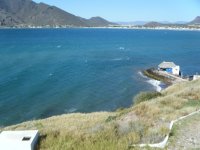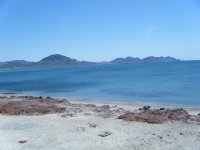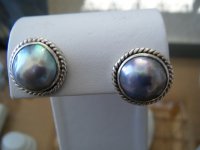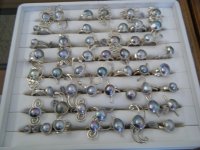You are using an out of date browser. It may not display this or other websites correctly.
You should upgrade or use an alternative browser.
You should upgrade or use an alternative browser.
Heading To Guaymas!
- Thread starter jshepherd
- Start date
Pearly Shell
New Member
- Joined
- Sep 5, 2008
- Messages
- 376
I can see us making time to ruckus while visiting the pearl farm. 
waimeamomi
Natural Pearl
- Joined
- Jun 12, 2008
- Messages
- 1,238
And I could visit the pearl farm without ruckusing (there). Maybe a pre or post regular ruckus trip.
Lagoon Island Pearls
Well-known member
- Joined
- Dec 8, 2009
- Messages
- 2,117
It's too hot to go to Guaymas July - September. And in September, hurricanes are a possibility! Maybe a spring 2011 trip minus the ruckus?
I would love to visit sometime during winter months.
The food, farm and area...... very nice.
Caitlin
Well-known member
- Joined
- Dec 11, 2004
- Messages
- 8,502
Haiku for Douglas, Henrique, Manuel, Jesus
I.
Sea of Cortez pearl
Shimmering summer water
birthed florescent orbs.
II.
Three Princes of Pearls
working with simple supplies
nurturing the bay.
III.
Guaymas Sonora
Not an easy place to live
Save for rainbow pearls.
IV
Bacochibompo
gives rainbow pearls to the world.
Most people don’t notice.
I.
Sea of Cortez pearl
Shimmering summer water
birthed florescent orbs.
II.
Three Princes of Pearls
working with simple supplies
nurturing the bay.
III.
Guaymas Sonora
Not an easy place to live
Save for rainbow pearls.
IV
Bacochibompo
gives rainbow pearls to the world.
Most people don’t notice.
Last edited:
Nerida
Member
- Joined
- Jan 2, 2008
- Messages
- 1,926
Beautifully expressed, thank you, Caitlin-----------
same sentiment from me...
Caitlin
Well-known member
- Joined
- Dec 11, 2004
- Messages
- 8,502
I went to the Cortez Pearls farm 3 days in a row in the company of Blaire and Jeremy. It is located in Guaymas, Sonora, Mexico, in a former Bacochibampo (Ba co-chi-bam-po) bayside private college for marine studies. In fact, both Douglas and Henrique went to college there together. Now the college is closed but the complex of buildings has been recycled a bit here and there. It is home to a private high school now. What was formerly the grand entrance of the previous tenant, houses the learning center of Sea of Cortez’ small farming operation and a store with nothing but Sea of Cortez cultured pearls. The operational center is down the hill, right on the water, shown in the picture above.
[FONT="]
Blaire and Jeremy relaxing.
[/FONT]
[FONT="]
Blaire and Jeremy relaxing.
[/FONT]
Attachments
Last edited:
Caitlin
Well-known member
- Joined
- Dec 11, 2004
- Messages
- 8,502
Douglas, Enrique and Manuel are the trifecta that manages the only sea pearl farm on this continent, indeed, in the New World. As well as being pearl farmers, these guys are well educated, trained scientists, with bigger dreams than they have yet accomplished. No, not dreams of expanding until they are huge and rich; there is little room for that in their philosophy. They are not in it for the money though at least one wishes the farm income were enough to support him without taking extra jobs. They are in it for the pearl of the Rainbow-lipped pinctada, a pearl oyster unlike any other in the world. And by extension, they are in it for the shell the pearl came in, the bay the shell grew in, the sea the bay comes from. And so on.
As it is, Sea of Cortez Pearls are the rarest cultured pearls in the world. The four major cultured pearl types: freshwaters, akoyas, south sea and Tahitian pearls all produce tons of pearls a year, a mountain of pearls. Part of the rarity of The Sea of Cortez pearls is because they come from another species of pearl oyster entirely, the pteria sterna, the rainbow-lipped oyster. This farm produces a total of about 12 pounds of pearls a year, total. That’s it. That’s rare and exclusive by any measure.
These are not ordinary pearls. Though they are a “black pearl” as the Tahitians are and there is some overlap in the amount of color between Tahitians and the Cortez pearls, the Cortez pearls have a high rate of almost abalone-like colored pearls, unlike the Tahitians do . OK, let’s say we can imagine they are ? Tahitian, ? abalone-like colored pearls in their best examples. The quality of the color does vary as it does in Tahitians. As it goes down, the pearls become more blue silvery, though the same colors are present, they are more subtle. Not as saturated.
One more unique quality that these pearls possess is they fluoresce under black lights. They glow red! No other cultured pearl can lay claim to that! What an easy test for authenticity. This pearl will not need much testing by the GIA.
As it is, Sea of Cortez Pearls are the rarest cultured pearls in the world. The four major cultured pearl types: freshwaters, akoyas, south sea and Tahitian pearls all produce tons of pearls a year, a mountain of pearls. Part of the rarity of The Sea of Cortez pearls is because they come from another species of pearl oyster entirely, the pteria sterna, the rainbow-lipped oyster. This farm produces a total of about 12 pounds of pearls a year, total. That’s it. That’s rare and exclusive by any measure.
These are not ordinary pearls. Though they are a “black pearl” as the Tahitians are and there is some overlap in the amount of color between Tahitians and the Cortez pearls, the Cortez pearls have a high rate of almost abalone-like colored pearls, unlike the Tahitians do . OK, let’s say we can imagine they are ? Tahitian, ? abalone-like colored pearls in their best examples. The quality of the color does vary as it does in Tahitians. As it goes down, the pearls become more blue silvery, though the same colors are present, they are more subtle. Not as saturated.
One more unique quality that these pearls possess is they fluoresce under black lights. They glow red! No other cultured pearl can lay claim to that! What an easy test for authenticity. This pearl will not need much testing by the GIA.
Attachments
Last edited:
Mikeyy
Pearl Diver
- Joined
- Dec 7, 2006
- Messages
- 1,083
Don't ya just love the sea of Cortez. Its like a flooded moonscape. I have spent a lot of time down in Mulege and La Paz. In fact I spent some time down there years ago with Dr. Mario Monteforte. He was trying to get investors to help start a pearl farm. He was working on a hatchery and was raising spat that he and his students had collected with onion sacks. It was a really nice time. I'll try to post some pictures. He grew a few pearls.....well they were kind of like pearls. But they never really got a serious seeding program going. Not enough investment. And I think I remember that the government wasn't cooperating as well as they could have.
Dr. Monteforte was a good guy though. And we drove all the way to Cabo San Lucas.
Went fishing for tuna, Got slammed at Cabo Wabo......The usual stuff.
There is more to the story but it will have to wait until the ruckus. LOL
Dr. Monteforte was a good guy though. And we drove all the way to Cabo San Lucas.
Went fishing for tuna, Got slammed at Cabo Wabo......The usual stuff.
There is more to the story but it will have to wait until the ruckus. LOL
Caitlin
Well-known member
- Joined
- Dec 11, 2004
- Messages
- 8,502
Hi Mikeyy
I hope you do put them up!
I saw a busload of tourists visit the farm. After the farm they could return to the information center and look at jewelry featuring mostly rainbow mabe pearls. They looked desultorily, some bought and they left.
Later that night, I lay insomnia-addled, my mind overwhelmed and racing from all the input, I had a fantasy of standing up on the balcony above the showroom floor and clapping for the attention of the tourists. I would introduce myself saying I am part of a group of pearl experts (hang my head- this was a fantasy!) that has been visiting for three days. That they (the tourists) may not realize it, but if they do not get a Sea of Cortez pearl now, while they were here, they would be missing the chance of a lifetime to get their hands on one of the most rare and beautiful pearls in the world.
These pearls should be priceless. Instead, tourists can buy them at the farm store at very low prices. Except from the farm itself, there are only three other places in the world you can buy them and they will cost far more.
These are the earrings I picked out.
I hope you do put them up!
I saw a busload of tourists visit the farm. After the farm they could return to the information center and look at jewelry featuring mostly rainbow mabe pearls. They looked desultorily, some bought and they left.
Later that night, I lay insomnia-addled, my mind overwhelmed and racing from all the input, I had a fantasy of standing up on the balcony above the showroom floor and clapping for the attention of the tourists. I would introduce myself saying I am part of a group of pearl experts (hang my head- this was a fantasy!) that has been visiting for three days. That they (the tourists) may not realize it, but if they do not get a Sea of Cortez pearl now, while they were here, they would be missing the chance of a lifetime to get their hands on one of the most rare and beautiful pearls in the world.
These pearls should be priceless. Instead, tourists can buy them at the farm store at very low prices. Except from the farm itself, there are only three other places in the world you can buy them and they will cost far more.
These are the earrings I picked out.
Attachments
Caitlin
Well-known member
- Joined
- Dec 11, 2004
- Messages
- 8,502
There are some lovely 18 ct gold pieces set with the pearls, beautifully displayed, but there are many, many more mabe pearls set in .925. I would say to the tourists, “Pick the pearl you like best. Do not worry about the settings; they can easily be redesigned to your personal taste later.”
I was short-circuited a bit by the number of rings crowded together in one case, then another, with rather indifferent settings. It was too crowded and my eye bounced around and couldn’t settle on just one of the choir of little mabes clamoring for my attention.
I wish they were separated with more space between them- in less crowded cases with the emphasis on the mabes themselves. Each one has a different part of the spectrum. Each mabe is complex in and of itself and deserves space enough to expand to its full glory without the others crowding in on the edges.
I absolutely love the classic style of my earrings. That little band around the mabe pearl is a very traditional touch and indicates the southwestern origin of the jewelry. I see there are some more simple rings in there and I far prefer those.
I was short-circuited a bit by the number of rings crowded together in one case, then another, with rather indifferent settings. It was too crowded and my eye bounced around and couldn’t settle on just one of the choir of little mabes clamoring for my attention.
I wish they were separated with more space between them- in less crowded cases with the emphasis on the mabes themselves. Each one has a different part of the spectrum. Each mabe is complex in and of itself and deserves space enough to expand to its full glory without the others crowding in on the edges.
I absolutely love the classic style of my earrings. That little band around the mabe pearl is a very traditional touch and indicates the southwestern origin of the jewelry. I see there are some more simple rings in there and I far prefer those.
Attachments
Last edited:
pattye
Pearl Scholar
- Joined
- Dec 26, 2005
- Messages
- 11,535
Caitlin,
Adore your new mabe earrings, the silver is perfect, and your favorite metal also! Picking from all those beauties would be sooooo difficult! What value in $ is a person allowed to bring back from Mexico?
Do keep the stories coming------------
Adore your new mabe earrings, the silver is perfect, and your favorite metal also! Picking from all those beauties would be sooooo difficult! What value in $ is a person allowed to bring back from Mexico?
Do keep the stories coming------------
Similar threads
- Replies
- 19
- Views
- 3K
- Replies
- 1
- Views
- 181
- Replies
- 50
- Views
- 2K







